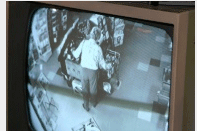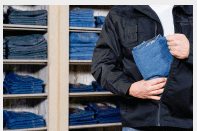 Many retailers invest thousands of dollars to protect themselves against theft. From surveillance to electronic devices, these retail shop owners try to find a way to reduce their shrinkage in a daily basis. Whether they are dealing with petty shoplifters, employee theft or organized groups, they have to know their problem first to be able to find a solution they can implement in their store. To read more about this common problem, follow the links below for more information.
Many retailers invest thousands of dollars to protect themselves against theft. From surveillance to electronic devices, these retail shop owners try to find a way to reduce their shrinkage in a daily basis. Whether they are dealing with petty shoplifters, employee theft or organized groups, they have to know their problem first to be able to find a solution they can implement in their store. To read more about this common problem, follow the links below for more information.
EASTON — The Easton Police Department reported a 61 percent increase in retail thefts in 2014 — from 163 retail theft cases in 2013 to about 263 in 2014.
In response to this increase, the EPD announced that each month it will release photographs of all individuals who were charged with retail theft.
There’s an understanding that to better prosecute and deter thefts, a partnership between retailers and law enforcement is vital, EPD said.
In August 2013, EPD also started a Retail Investigator’s Network, which brings together retail loss prevention/asset protection investigators, prosecutors and law enforcement from Easton and Denton.
During these meetings, solved and unsolved investigations are discussed, which has increased closure rates in Easton and Denton, police said. These meetings have opened lines of communications between retailers. These meetings are also used to educate everyone in crime trends and other criminal activity that’s associated with retail theft.
In 2014, retail loss prevention/asset protection investigators and law enforcement in Easton and Denton have saved retailers about $142,722, EPD said.
Dover Police See 19% Drop In Reported Shoplifting Cases Since Posting Arrests Online 1-6-15
The Dover Police Department saw a 19% drop in shoplifting complaints since beginning the Shoplifter Notification Program on August 7th, 2014. The program which posts mug-shots of persons arrested for shoplifting on a weekly basis on the department website and social media outlets, has helped to reduce shoplifting incidents during the 4-month trial period. The reduction in shoplifting incidents during the trial period also led to a 12% drop for the entire calendar year compared to 2013 numbers and bringing the total number of shoplifting cases below 1,000 for the first time since 2010.
From 2011 through 2013, the Dover Police Department investigated 3,290 shoplifting cases, averaging 3 per day during that time period. In an effort to help reduce the amount of shoplifting cases in the City of Dover, the department began the weekly notifications, displaying the names and booking photos of those arrested. The goal of the notifications is to notify Dover merchants of offenders in hopes of being able to reduce the number of shoplifting cases. The majority of shoplifting cases are committed by repeat offenders and the department’s goal is that by releasing the information, store employees will be better informed when monitoring their stores and inventory, and that suspects will think twice before stealing merchandise in fear that their name and photo will be shared with the public.
A teenager has been arrested after he allegedly held up a petrol station while wearing a flower pot on his head and wielding a chainsaw, though he only managed to steal a bottle of soft drink.
The man entered the 7-Eleven service station in Ipswich, Queensland, at 4.30am on Monday, wearing a flower pot on his head in an attempt to conceal his identity, it will be alleged.
He is accused of lunging at the shop assistants while holding a running chainsaw, and demanding money from them.
Chainsaw attack: The 19-year-old held up a service station wearing a flower pot on his head. He then made demands for money from the male attendant
The terrified shop assistants, who were cleaning a coffee machine at the time he entered, claim they then retreated into a back room and called police.







